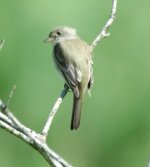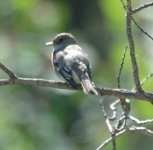Howdy,
I would agree that it would be difficult to be definitive on a particular species, but the possibilities for each of these can be narrowed to much less than 6 species
The first almost has to be either Willow or Alder. Its (1) pretty big-billed, (2) back brownish not greenish or yellow or gray, (3) whitish throat and belly, and has a (4) narrow eye-ring. Pacific Slope and Yellow-bellied are excluded by (2), (3) and (4); Hammonds', Gray, Least and Dusky by (1) and (4), Acadian by (4). This leaves only Willow and Alder [Alder can be late migrants, so range not useful in early June]. characters (1-4) are pretty definitive for this superspecies pair.
The second is not a good picture, but it can be seen to have a 1/2 dark-tipped lower mandible on a thin bill. This pretty well excludes Pacific-Slope, Yellow-bellied (also by by lack of green tones in back), Willow, Alder and Acadian. The distinct front of eye-ring also excludes Willow and Alder.
We are now down to Least (some of which can have dark in distal lower mandible), Dusky, Hammond's and Gray. And here, it may become less definitive. The general rounded head shape tends to disfavor Hammond's and Least. Gray should show much less than the distal half of the mandible dark, and a much less distinctive eye-ring, and much less contrast in wing bars and tertial edgings. I think Gray is safely excluded. The contrasting pale edgings on tertials may favor Least. The bill looks a bit too long for Hammond's and too slight for Least, about right for Dusky. The rounded head tends to favor Dusky, although the contrasty pale edgings on tertials, and long primary extensions would not. So down to three species.
It is also important to note that it is tough to call some birds from single photos, [sometime if just from angle or quailty of photo), and it is probably more so for Empidonax flycatchers. A single photo may provide misperceptions on some characters that, when seen from other angles, look different. Multiple photos also help weigh the value of some characters (as when one character appears the same in all 3 photos, while different angles provide different perceptions on another character).
So I wouldn't just throw up my hands, but agree that a definitive ID may not be possible from these photos. But there are probably some real experts out there. Maybe, this will fish them out.
CHEERS, JOE
_______________________________________________________
cayoncreekman said:
It's safe to narrow them down to about six species. I don't think there would be anything other than a 'guesstimate' after that.
The issue with other criteria is that a lot of literature simply repeats other sources and isn't based on original studies. Much of the terrain is really difficult to access and it's almost imposible to know from just the visuals what's a variation on a species. A distinct bird song or call is the best marker but even those have a lot of variation in our flycatchers. The mountain ranges tend to run north/south from Alberta to the Pacific and fauna groups are isolated from each other. Unique ecosystems have evolved on the slopes and in the valleys. An entymologist or lepidopterist can can find new species of spiders, moths, etc. on every outing especially where there is no road access. Puting some of British Columbia's flycatchers into a distinct species is sometimes based on broad generalizations.





